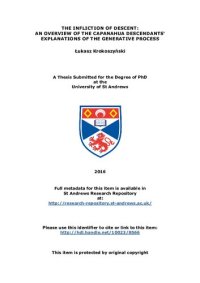
Ebook: The infliction of descent: An overview of the Capanahua (Pano) descendants' explanation of the generative process
Author: Łukasz Krokoszyński
- Genre: Other Social Sciences // Ethnography
- Tags: Peru, Pano, Panoan, Capanahua, Kapanawa
- Series: PhD Dissertation
- Year: 2016
- Publisher: University of St Andrews
- City: St Andrews
- Language: English
- pdf
This thesis traces the ways of explaining the generative process by the eastern
Peruvian descendants of the Capanahua. These predominately Spanish-speaking
people tend to emphasize the discontinuity with their ancestors, a little known
Panoan-speaking indigenous population of the Western Amazon. Based on
ethnographic fieldwork and transcriptions of recorded conversations, this
presentation follows and reconstructs a salient frustrative-generative dynamic in a
wide range of representations, wherein alterations of self-containment or
perceptibility incept the processes of differentiation and discontinuity. These
processes guide a local conception of “descent” as infliction.
Implications of this dynamic are examined for the formulations of kinship. The
familial relations, explicitly based on notions of consanguinity and filiation – are cast
in an ambiguous, if not predominately negative light. Procreation is formulated in
predatory, parasitic terms, and shares dynamics with pathogenic causality and
aetiology. As such, it does not naturally contribute to reproduction and continuity,
but rather frustrates it by introducing difference into the vertical axis. Such results
also produce horizontal differences and hierarchies, encoded as the person’s
divergent, hidden “descent” in the always “mixed” social life.
This image of the generative process is instrumental to understanding the
villagers’ explanations of the acculturative processes. Because representations of
acculturation focuses on the idiom of procreation and its frustrative results, it
appears as the very function of procreative dynamics. This produces a series of
associations between the progeny and sociality, focusing on their inherently “third” or
external position and perpetual dividuality of belonging/containing. Such ambiguity
might be tamed and everted, to produce cleansing or encompassment that
counteracts the divisive continuity of time (qua descent, history, or kinship). In a
contemporary context, these formulations are seen reflected in the villagers’ construal
of the Peruvian state as the urban environment that is hierarchically closer to the
ideal originality and beautiful imperishability than the smaller, isolated unities of
rural ancestors.
Peruvian descendants of the Capanahua. These predominately Spanish-speaking
people tend to emphasize the discontinuity with their ancestors, a little known
Panoan-speaking indigenous population of the Western Amazon. Based on
ethnographic fieldwork and transcriptions of recorded conversations, this
presentation follows and reconstructs a salient frustrative-generative dynamic in a
wide range of representations, wherein alterations of self-containment or
perceptibility incept the processes of differentiation and discontinuity. These
processes guide a local conception of “descent” as infliction.
Implications of this dynamic are examined for the formulations of kinship. The
familial relations, explicitly based on notions of consanguinity and filiation – are cast
in an ambiguous, if not predominately negative light. Procreation is formulated in
predatory, parasitic terms, and shares dynamics with pathogenic causality and
aetiology. As such, it does not naturally contribute to reproduction and continuity,
but rather frustrates it by introducing difference into the vertical axis. Such results
also produce horizontal differences and hierarchies, encoded as the person’s
divergent, hidden “descent” in the always “mixed” social life.
This image of the generative process is instrumental to understanding the
villagers’ explanations of the acculturative processes. Because representations of
acculturation focuses on the idiom of procreation and its frustrative results, it
appears as the very function of procreative dynamics. This produces a series of
associations between the progeny and sociality, focusing on their inherently “third” or
external position and perpetual dividuality of belonging/containing. Such ambiguity
might be tamed and everted, to produce cleansing or encompassment that
counteracts the divisive continuity of time (qua descent, history, or kinship). In a
contemporary context, these formulations are seen reflected in the villagers’ construal
of the Peruvian state as the urban environment that is hierarchically closer to the
ideal originality and beautiful imperishability than the smaller, isolated unities of
rural ancestors.
Download the book The infliction of descent: An overview of the Capanahua (Pano) descendants' explanation of the generative process for free or read online
Continue reading on any device:

Last viewed books
Related books
{related-news}
Comments (0)